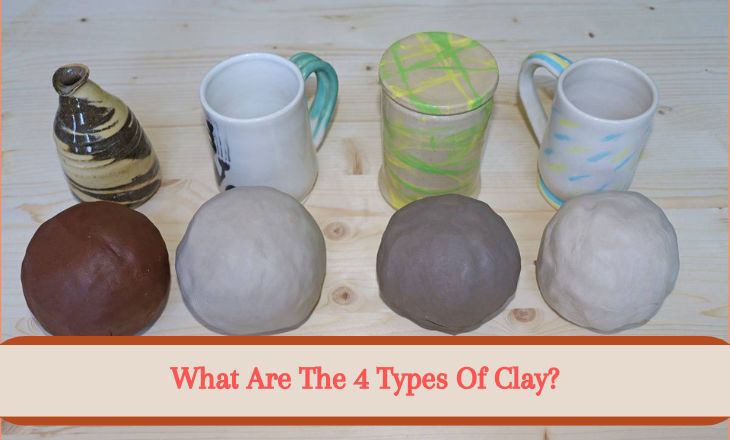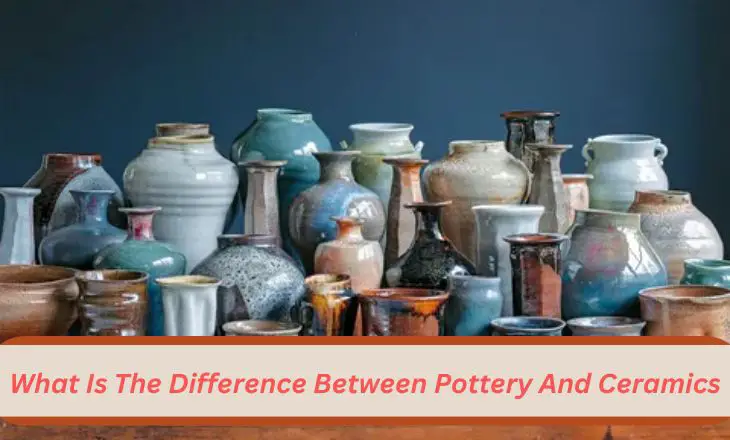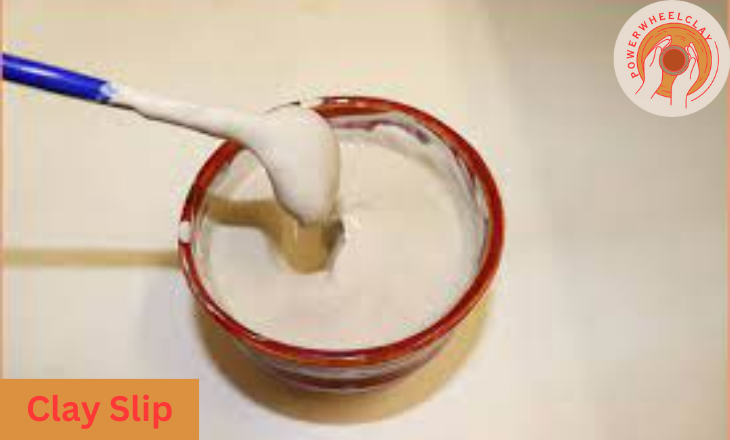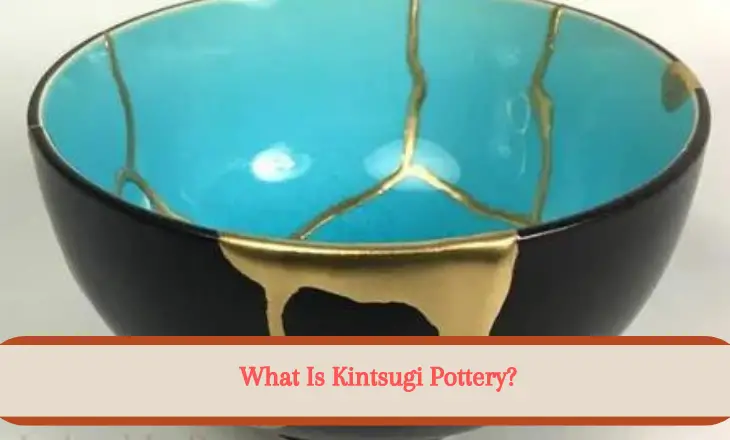What Are The 4 Types Of Clay? Main Clay Types
Clay is found in sedimentary rocks with clastic structures. Naturally We found clay made from layer after layer of tiny stones. Here We Mention 4 Types of Clay that is very Common. All of these 4 types of Clay can be used to make pottery.
When You want to start making pottery painting ideas, but you’re not sure which kind of clay will work best. This post will discuss the types of clay used in pottery Ideas making as well as the characteristics of each type of clay.
WHAT ARE THE 4 TYPES OF CLAY
You can select the ideal clay for your upcoming project by being aware of these 4 types of clay. Clay comes in four different varieties. They can all be used to manufacture pottery, but because of their varied textures, hues, and flexibilities, the finished product would vary greatly.

Here is A List of Clay Types
- Earthenware clay
- Stoneware
- Porcelain clay
- Ball clay
EARTHENWARE
Earthenware is smoother and possibly more porous than stoneware and porcelain because it has not been burned to the degree of vitrification of the tissue The body can be glazed, fully coated, or embellished with slip, a liquid clay combination applied prior to fir.
Terracotta, also known as terra cotta, is a time-honored earthenware clay that has been used for centuries in various cultures around the world. Its warm reddish-brown color and porous nature make it an attractive choice for creating pottery.
What It’s Used For
You most likely have ceramics all around you if your home is made of brick. For thousands of years, earthenware has been used in construction throughout numerous cultures.
EARTHENWARE POTTERY
Earthenware is a type of clay that is easy to work with and has been used for centuries to create functional and decorative pottery. Its low firing temperature makes it suitable for creating items such as planters, dishes, and decorative figurines.
Firing
Earthenware, with its porous nature, requires a meticulous three-step firing process to ensure structural integrity when exposed to moisture. The initial bisque firing serves to remove organic matter and other impurities from the clay, setting the stage for subsequent transformations.
This preliminary step also toughens the earthenware and prepares it for later stages of firing. You’ll finish a bisque firing first.
- Bisque Fire Temperature Range: 1828° to 2088° F
- Glaze Fire Temperature Range: 1728° to 1945° F
STONEWARE
stoneware pottery that has been fired at a high temperature . usually opaque, some stoneware is so thinly potted that it is somewhat translucent. Stoneware clay is the foundation of a timeless art form that has been cherished for centuries. This durable and versatile material creates pottery that has been fired at a high temperature, resulting in pieces with exceptional strength and resilience.

The unique blend of minerals in stoneware clay produces stunning earthy tones and textures, giving each piece its own distinct character. In addition to Japan and South Korea, Italy has also been at the forefront of utilizing almost stoneware clay in modern ceramics.
With a legacy of excellence in craftsmanship and design, Italian artists have integrated this material into their repertoire to produce sophisticated pieces that merge functionality with artistic expression.
What It’s Used For
Stoneware use works well for practical ware, such as baking, cooking, and liquid storage, because it is less porous than other clay types. Stoneware has extraordinary durability.
For beginners, I suggest using stoneware. Because it is a flexible clay with transparent qualities after fire, it has practical applications. , compared to its clay brothers and sisters, it’s a safer bet for a successful project. It’s a great option if this is your first time working with Greenware Ceramics.
Firing
Stoneware clay firing is a fascinating process, and the speed at which it reaches the bone-dry stage before firing sets it apart from other types of clay. This rapid progression adds an element of excitement and anticipation to the pottery-making journey, as artists. fire stoneware properly, a contemporary kiln must slowly raise the temperature.

- Temperature range for firing: 2124–2264°
PORCELAIN
A fine, typically white clay that is created when aluminous minerals weather; utilized as a filler and absorbent in ceramics : terra alba, kaolin, kaolin, china clay, and china stone beginners. Its smooth, fine texture makes it ideal for creating delicate pottery pieces, but its unforgiving nature requires precise handling.
Porcelain is less forgiving than other types of clay, as it tends to warp and crack easily during the drying and firing process. Beginners may find themselves challenged by the need to pay meticulous attention to every detail of their work, from shaping to drying and glazing. Despite these challenges, working with porcelain offers a valuable learning experience.
The demands of using this material push beginners to develop patience, precision, and the great pottery thrown down season 5 craftsmanship in their pottery making.
FUNCTIONAL USES OF PORCELAIN
Porcelain, typically associated with delicate teacups and elegant dinnerware, has unexpectedly made its mark in the realm of functional utilities. Beyond its role in fancy meals, porcelain plays a crucial part in creating sturdy and reliable toilets and bathtubs.
functional uses of porcelain, it’s important to consider the higher temperatures required for certain items. Unlike delicate fine china, functional porcelain items such as oven-safe bakeware and durable dinnerware need to withstand much higher temperatures. This characteristic makes them versatile and practical for everyday use in the kitchen.
DECORATIVE USES OF PORCELAIN
Because of its delicate beauty and ageless elegance, porcelain has been a treasured medium for making ornamental knickknacks, dolls, and collectibles. Porcelain goods, such as elaborately painted figures and elaborate tea sets, have graced homes and delighted collectors for ages. And the great pottery throw down cast uses.
Whether it’s a gorgeous trinket box or a charming vintage doll, the allure of these porcelain pieces is their ability to give a touch of sophistication to any setting. In Japanese culture, the art of traditional tea ceremonies holds profound significance, and porcelain plays an integral role in this revered tradition.
Firing
Firing is the pivotal process that allows porcelain clay to transform into durable, functional objects. At the core of this transformation is the fusion of materials driven by intense heat. The high temperatures during firing create a chemical reaction within the clay particles, causing them to bond and set in their formed shapes permanently. This process establishes the structural integrity of the vessel, ensuring it can withstand daily use while retaining its delicate beauty.
- Firing Temperature Range: 2,200° and 2,600° F
BALL CLAY
Ball clay, although less abundant than other types of clay, possesses unique properties that make it highly sought after in the ceramics industry. Ball clay and earthenware share the ability to create a white finish after firing, their differences in origin and composition offer artists diverse possibilities for artistic expression.
Whether seeking strength and smoothness from ball clay or embracing earthy warmth from earthenware, each material presents distinct advantages that cater to specific creative visions Britain’s long-standing relationship with ball clay stretches back centuries, with the earliest known ball clay vessels being unearthed in England.
What It’s Used For
Ball clay, traditionally known for its use in floor and wall tiles, is now finding new applications in the ceramic industry. Its unique plasticity and bonding properties make it suitable for shaping mugs, plates, and other ceramic products.
Firing
With its exceptional firing properties, ball clay has captured the attention of potters around the world. Beyond its white finish after firing, this remarkable clay is celebrated for its incredible malleability and mineral purity. This unique combination allows artists to unleash their creativity with ease, forming intricate shapes and designs that retain their pristine appearance post-firing.
SUMMARY CHART
| Type of Ceramic | Firing Temperature | Characteristics | |
| Stoneware | 1200-1300°C | Dense, durable, and non-porous. Often used for functional pieces such as dishes and mugs. | |
| Porcelain | 1250-1450°C | Translucent and delicate. Often used for decorative pieces and fine tableware. | |
| Earthenware | 800-1100°C | Porous and less durable than stoneware. Often used for decorative pieces and tableware. | |
| Ball Clay | 1250-1400°C | Ball clay is popular with many potters because of its white finish after firing. Ball clay is very malleable and is rather mineral pure. |
OTHER CLAYS
There are common types of clay bodies you may have heard about before, Other clays like polymer clay and air dry clay steal the show. traditional ceramic clay, these options don’t require firing equipment, making them perfect for projects with tight timelines.
CONCLUSION
Understanding the 4 main types of clay—kaolin, ball clay, stoneware clay, and earthenware clay—is essential for anyone working with ceramics or pottery. Each type has unique characteristics that influence its suitability for specific projects and techniques.
By familiarizing oneself with the properties and uses of these clays, artisans can make informed decisions about which type to use based on their desired outcomes. Explore the vast world of ceramic possibilities by experimenting with different types of clay to discover your own creative potential.






